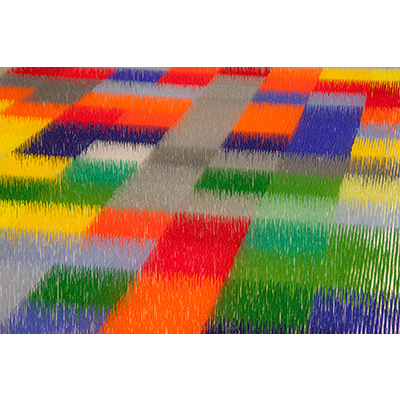An astonishing, 1400 square foot luminous landscape of bold color, the artist’s largest sculpture to date – assembled by hundreds of hands
Exhibition also includes a series of the artist’s beaded woven canvases
in solid grays and other hues
“I’m interested in breaking down paradigms, not upholding them,” says Lou.
Liza Lou’s monumental shimmering work Color Field – on view at the Neuberger Museum of Art, Purchase College, SUNY from November 8, 2015 through February 21, 2016, in the exhibition Liza Lou: Color Field and Solid Grey – is the artist’s largest sculpture to date. Blanketing the Museum’s gallery floor, the 1400 square foot work, with its thousands of blades of grass (small stainless steel wires) arranged in brilliant squares of color (over 2 million tiny glass beads are strung on the wires), took four years, a team of 30 Zulu women artisans in Durban, South Africa, and hundreds of volunteers in Westchester County to assemble, all under the artist’s direction.
Although its name seems to pay homage to the original Color Field painters of the 1950s and 60s such as Mark Rothko and Helen Frankenthaler, Liza Lou, a MacArthur Foundation prize-winning artist, emphasized that the title is meant to be read as more open-ended. “I titled the work Color Field for the obvious associations to both an art movement and the fact that it is indeed a physical field of color,” she said in a recent conversation with the Museum. “However,
I think of the work as a meditation on process as harvest and growth, as well as color as subject matter.”
Walking alongside the periphery of this luminous field, the colors blend and blur slightly in a moiré effect. “It becomes a physical experience,” says Lou, whose first and smaller version of Color Field was displayed at the Museum of Contemporary Art San Diego in 2013. Lou also describes Color Field as a celebration of the hand made. “There is a kind of apotheosis of the human hand,” she says. “Color Field started with a very simple activity, that of threading glass beads onto pieces of stainless steel wire, but there is a tipping point where simplicity yields to something larger, not only in scale, but in depth and complexity, and for me, that’s where things start to get interesting.” The effect can be thrilling.
The exhibition also includes Lou’s Solid Grey and Color/White canvases, a series of ‘paintings’ woven out of glass beads. “Every canvas is a solid color,” says Lou. “Beads are a dense material; they are uniform and perfectly round, and stitched in the same methodical way. But each woven strip comes back with the imprint of the person who wove it, so there are subtle variances. What emerges is a kind of patina of process.”
Helaine Posner, Chief Curator, Neuberger Museum of Art, who curated the exhibition, sums it up this way: “Lou’s labor-intensive processes invite viewers to experience the work at both the level of visual wonder and critical analysis,” she says. ”Lou uses millions of hand-placed glass beads to cover surfaces such as appliances, security fences, jail cells, and barbed wire. It is only when one begins to look more closely at the themes of her work that one understands the seriousness of her subject matter – the pleasure, pain, vulnerability, captivity, and injustice, both personal and political. In recent works, such as Color Field, Lou engages the history of modernism, referencing color field painting and geometric abstraction, while her monochromatic beaded canvases draw on the subtle color abstractions of artists Agnes Martin and Anne Truitt.”
Beads: “The Perfect Metaphor for Sexism”
Liza Lou burst onto the international scene in the mid-1990s, when her sculpture Kitchen, a life-sized beaded work that painstakingly took five years to make, was included in an exhibition at the New Museum in New York City. In an interview with W magazine, the artist described it as her attempt to transform the drudgery of a suburban kitchen into something monumental and heroic.
“I chose to use a material that is aligned with craft with my eyes wide open,” she explained, “Beads are a perfect metaphor for sexism; they are feminine and at times have been denigrated as a serious art material. I choose to stand on the side of the handmade, which also places me on the side of laborers. My flag may not always wave in the ivory tower, but I’m interested in breaking down paradigms, not upholding them.”
After she won the Genius Award from the MacArthur Foundation in 2002, Lou established a studio in Durban, South Africa, seeking to recruit unemployed artisans and pay them sustainable wages to help her with her beadwork. “But then the singing happened,” as she was reported saying, “and the conversations began.” She was moved by the Zulu attitude towards process, and experienced the “mythical aspects” of beads, used in traditional and religious ceremonies. She now divides her time between South Africa and California, where she maintains studios.
Liza Lou has exhibited in museums and galleries around the world, including The Metropolitan Museum of Art; Whitney Museum of American Art; Victoria and Albert Museum; Los Angeles County Museum of Art; Minneapolis Institute of Arts; Smithsonian Institution of American Art; the New Museum; Museum of Contemporary Art, Tokyo; Fondation Cartier pour l’art contemporain, Paris; and Deste Foundation for Contemporary Art, Athens.
Liza Lou: Color Field and Solid Grey is organized by the Neuberger Museum of Art, and made possible with generous support from Donna and Marvin Schwartz. Additional support is provided by ArtsWestchester, with support from Westchester County government.


